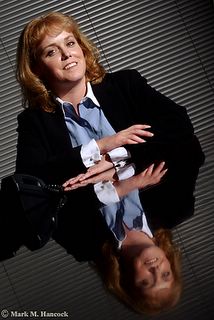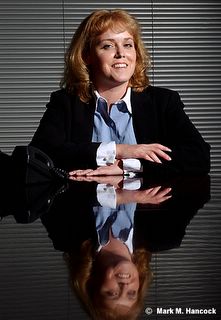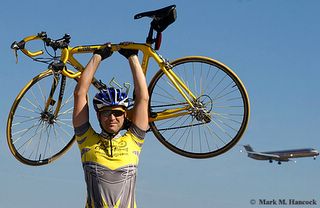Apparently digital workflow is a big issue to some folks. For most PJs it's only a minor part of the job. It has a specific rote pattern. However, it must be followed semi-exactly, like processing film or making a print. This entry is geared toward folks who haven't been in a professional scanning room (the modern equivalent of a darkroom). We'll discuss personal digital workflow in a different entry.
This is a long post because all of these steps are required for each assignment. Consequently, there's no way to break it down to reasonable bites. The example below uses one assignment. For non-immediate deadline assignments, repeat each step for each assignment before moving to the next step while processing multiple assignments.
I doubt any two scanning rooms around the world are exactly alike. Different organizations use different software and hardware. It's important for freelancers to rapidly adjust to whatever situation they face at different locations. It's also important to know what steps each organization uses and allow time for these processes.
Scanning stationsIn a large scanning room there can be 20 or more scanning stations. Each station is configured slightly different depending on when equipment was last replaced. Obviously, it's best to use the most powerful computer with the biggest screen and the fastest CD writer. However, other issues ultimately determine which stations different PJs prefer.
EquipmentMost digital scanning stations have the same core elements: a computer (normally a Mac), a large-screen monitor, one or more card readers (internal or external), a CD writer, a negative scanner, a small articulated desk lamp, a phone, an adjustable desk, an adjustable chair and normally a dictionary within reach. Often phone and style books are located in one central location for the entire scanning room.
The station is normally connected to the local area network (LAN) for access to the central server, the Internet and printers. Some scanning rooms and LANs may be wireless and require PJs to transmit from office desks via laptop Airport connections.
Personal preferencesSometimes the combination of equipment isn't calibrated exactly to the press or has some strange quirk which might slow the PJ down. Over time, PJs adjust to a set of stations they find acceptable to their shooting style, work patterns and eyesight (color balance and brightness). Each PJ gravitates toward certain machines as a result and the scanning room has a certain chaotic calmness.
Honestly, it's better to work on a slightly slower computer PJs know than a new computer with new problems to overcome. By all means learn the new computer when there's time, but don't blow deadline because the Wiz-Bang 10,000 is available and you always wanted to try it. Knock out the work first and then tinker.
As an example, the most powerful computer in the newsroom at my university required the user to occasionally remove the case and bang on the hard drive with a metal scissors handle. This isn't something someone needs to learn with 10 minutes until deadline.
Check suppliesDepending on the scanning room and how close to major deadlines PJs arrive, station time is limited. Before PJs start into the workflow, they need to verify they have all image cards,
assignment forms and
cutline information. If something is missing, get it before starting.
Often, it's a matter of going to the car to get what the PJ forgot to bring into the office. Sometimes, it requires a call to verify information. It's best to make calls before starting the process so everything is resolved simultaneously rather than waiting for a call back as deadline approaches.
IngestIn all cases, the point of the first step is to back-up the images from the flashcard onto a second (hopefully stable) platform. As long as two copies of the images exist, PJs can begin to breathe easier.
Place the card into a reader (an adapter may be required). Many organizations use
Photo Mechanic, for the initial sequences. Smaller organizations may immediately cut CDs or even copy images directly onto the hard drive of a single computer.
With Photo Mechanic, PJs are required to complete a template of information before the images are ingested and stored onto the hard drive. PJs write a generic cutline which applies to all images on the card. They also fill out fields for locations, assignment numbers, slug lines, PJ's name, assigning departments and so forth. Double check all information for accuracy before ingesting. If something is wrong, it takes twice as long to fix it later.
Specifically notate any changes from the assignment at the bottom of the cutline field with a triple-asterisk lead (***). This is normally considered notes to the editor for review and confirmation. For example:
*** Subject's name is Marri with two "r"s and an "i." She's from Detroit not Seattle.Upon the command to ingest, all information is imbedded (copied into) the file for each image as the images are copied and stored on the hard drive of the ingesting computer.
The ingestion process takes a few minutes. Once complete, remove the flashcard and place it in a safe location (card wallet).
Cut CDMany large systems don't require CDs anymore due to more efficient, redundant backup measures elsewhere in the workflow. For smaller organizations, the CD becomes the de facto archive. For freelancers, it's always important to cut a CD for personal archives.
Common CD burning programs are
Toast (Mac) and
Easy Media Creator (PC), both by
Roxio.
This step can be moved further down the workflow for tight deadline assignments. However, it's best to have the CD at this point in the workflow. Something could happen to the network, computer or electrical system and CDs are the singular multi-platform copy of the images.
Remove the burned CD, use a bold permanent marker and label it with assignment number, date, PJ's name and content keywords (i.e. East vs. West boys soccer, tanker explosion, etc...). Place the CD in a protective sleeve or case and set aside.
TransferIn this step, images are transferred from the computer hard drive to a central server of a high-capacity archive system. Unless the organization routinely deals with thousands of images each day, this step may not be incorporated into the workflow.
On really high-tech systems, a copy of the actual photo assignment is automatically imbedded into the file via the assignment number (as noted above).
Once the images are successfully transferred, they can be accessed in real time by anyone on the appropriate LAN (typically via
SCC MediaGrid) by assignment number or any key word(s) within the cutline or photo assignment.
This process takes several minutes and may take even longer depending on image traffic. It's best to have this process work in the background while the next workflow step is completed using images on the local hard drive.
Polling softwareParticularly busy systems may have polling software on the server. Polling software programs evenly distribute images into multiple folders from multiple users. The purpose is to avoid informational blockages and log jams.
PJs drag-and-drop or select images from one folder and place it into the polling software. The software then distributes it to 30 or more subfolders. The server then
employs a well-trained chicken selects images to copy onto the main server from these sub-folders. If one image has a fatal error, only one folder blocks up rather than all. The main advantage of this system is the speed at which PJs can begin to see their images on the main system rather than being trapped behind every PJ in order of transfer.
Smart CopyA common server polling software is Smart Copy. Personally, I don't like Smart Copy and bypass it every time. Instead, I drop images directly into the distributing folder of the program.
Depending on how the Smart Copy preferences are set on each scanning station, the program may completely delete all images if it's allowed control. This isn't as big a problem to Canon shooters as it is to Nikon shooters. The way Smart Copy dumps and deletes sub-folders can eliminate a Nikon shoot if the flatten folders box is left unchecked. The images vanish forever.
Pre-EditWhile images are copying to the server in the background, switch back to Photo Mechanic and open the folder as a contact sheet. If pre-editing in MediaGrid, skip the next sub-section, but understand it takes several minutes to load images into the grid and images caught in the system won't be visible.
Photo MechanicHere's another personal preference point. If you're a low-volume shooter (less than 100) and not on deadline, select all and view each image at a higher resolution in preview mode to select the absolute best images. If you're a high-volume shooter (300+) on deadline, you'll need to hold down the shift key and select potential images from the contact sheet view. Then view the selected images at the higher resolution.
Go through the selected images and checkmark those worth a second pass. Go back to contact sheet view. Hit Apple & "T" and Photo Mechanic highlights the checked frames.
Get a pen and, on the back of the assignment, write down each frame number along with a quality code as you make the second pass in preview mode. My quality code is blank for "meets the basic requirements," I use a "+" to set a crop mark, "++" to set a crop mark and frame marker, "+++" as best (crop and mark).
If one jumps out as amazing, I'll only use a "++" on the first pass, otherwise the frames are blank or "+." Then I do a quick second pass of the "+" images to see which are worth publication. I add one plus to the outstanding images and select the "best" image from this pass.
MediaGridOpen the appropriate MediaGrid folder where unedited images are stored. Most should be loaded by this point.
If PJs don't use Photo Mechanic, they can perform similar initial steps as above in MediaGrid. However, image resolution won't be as good in the preview screen and might lead to a soft image for the final selection. Additionally, PJs often won't know if images are missing (caught in the system).
If PJs used Photo Mechanic, open MediaGrid and locate the specific assignment (via verity search). Using the list on the back of the assignment, crop and mark images as noted on the back of the assignment.
Desk EditTake the assignment form to the photo desk and retrieve the assignment. Select your "best" first, then marked images and finally cropped (unmarked) and pull them up in preview mode (4x4 is good for comparison).
A photo editor looks at the assignment instructions and asks about the assignment. This is when PJs can present quick suggestions about which image is best for the story and why.
The editor then looks through the selected images and notes some images for approval. If the editor is satisfied, s/he copies some into the selected folder. If not, or if the editor has time, s/he looks through the raw take to see if any nice images were overlooked.
Occasionally, the editor gives some feedback about technique, composition or subject matter for future use. Remember, this is only a critique on the images presented.
Otherwise, assume you’re worthless and hang your head in shame... or weep uncontrollably. Both have the same results. ;-)
Image preparationGo back to the scanning room (hopefully nobody took your station or
changed the stereo)
prepare the images and write
cutlines using
Photoshop and the
SpellTools plug-in. Export the images into the main MediaGrid folder.
Print and checkMake a format print of each image (image with cutline). Take it to the light and look at the image for image problems (color balance, hot spots, etc...) if any. Carefully read the cutline for any errors in each data field. Double-check spellings of each proper noun. Make changes and reprint if necessary.
Desk verification and deliveryTake the absolutely correct prints (about one to four per assignment) to the photo desk. Give the prints to the photo editor. The editor looks at the print with a pen in hand. This is your signal to read out the spellings of each proper noun (in order) on the print in hand. We'll skip what happens if there is an error at this point (hint: it's
really bad).
As each print is approved, the photo editor signs their initials on the print. Then, depending on the images' sections, the editor either keeps or hands the prints back to the PJ. Those handed back need to be filed in the local section drawer or elsewhere the building (Lifestyles, Business, Sports, etc...).
ArchiveOnce prints are delivered, go back to the scanning room and fold (trifold, then in half) the assignment and all cutline information. Place this information in the sleeve with the CD.
At very large papers, this step is skipped by staffers because all the cutline information was shot by the PJ at the end of the shoot, and all images are streamed onto a digital platter jukebox in one or more other locations.
At smaller publications, file the CD in the archive drawers by assignment or archive number.
Depending on the contract, freelancers keep the CD and cutline information for their own files or make an additional copy of the CD and cutline info for the archive.
Breaking newsWhen PJs arrive "hot," most of the steps above may be completely skipped. If it's really hot, the PJ shows the raw take to the photo editor directly from the flashcard. The editor pulls up one or two images in Photoshop, the PJ corrects and writes cutlines on the spot. Format print the images. The editor verifies, and it's sent to layout.
Total time allowed: less than five minutes.
Then, follow most of the steps above to include all images properly in the archive.
ConclusionSince it's
contest season, the speed at which contest judges make decisions is appropriate after we understand the speed at which digital workflow of images takes place in the newsroom.
Typically everything listed above transpires in less than 30 minutes for a single assignment (about two to four images) or less than an hour for about three assignments (about eight to 12 images).
It also begins to show how busy the desk can become when there are more than 30 PJs reporting to a single location while editors from all other sections of the newspaper and outside sources (wires, etc.) are requesting images from the desk.
Enough for now,
Please also see
Create a personal digital workflow







